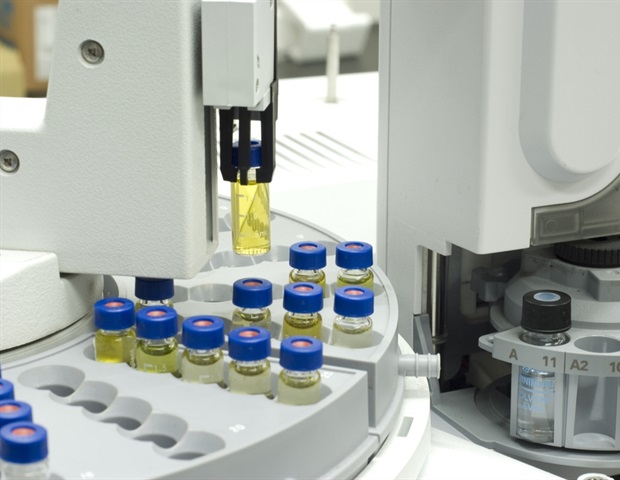Relief is coming for crime scene investigators and toxicologists who have struggled to accurately and swiftly identify drugs that have been seized by law enforcement and may be relied on as evidence at trial, thanks to a research partnership between West Virginia University and the U.S. Drug Enforcement Administration.
With more than $399,000 in funding from the National Institute of Justice, Glen Jackson, Ming Hsieh Distinguished Professor of Forensic and Investigative Science at the WVU Eberly College of Arts and Sciences, will advance techniques for analyzing psychoactive substances. His Expert Algorithm for Substance Identification, or EASI, will allow separate labs using different instruments to meaningfully share data about the chemical profiles of various drugs for the first time.
Both the DEA and Wiley, a commercial provider of software used by forensic science labs, will test EASI against other approaches to making speedy, reliable identifications of drugs like fentanyl, which have numerous close chemical “analogs.” Fentanyl analogs are so chemically similar that forensic analysis can mistake one drug for another, but there are important distinctions when it comes to their potential to cause addiction or overdose, for example.
“We’ll be looking at compounds that are of special interest to the DEA and are especially challenging to differentiate,” Jackson explained. “Those include variations on fentanyl, stimulants similar to MDMA or ecstasy, cannabinoid drugs including THC and CBD, and a set of substances closely related to the hallucinogen LSD. Existing algorithms are limited in their ability to distinguish analogs like these, to the extent that the drug identifications they make have questionable value in helping to meet the Federal Rules of Evidence criteria for admissibility in court.
“Compounding that problem is the fact that comparisons of drug identifications made using different pieces of equipment are notoriously unreliable, so currently every forensics lab has to spend significant time and expense creating their own in-house standards for chemical signatures. EASI can immediately help the DEA maximize its ability to discriminate between different strains of emerging synthetic drugs.”
Jackson said he believes there is no time to waste in improving toxicologists’ ability to identify substances like fentanyl. Centers for Disease Control and Prevention statistics show drug overdose death rates involving fentanyl and fentanyl analogs increased by 279% from 2016 to 2021, and a 2022 National Forensic Laboratory Information System report revealed that fentanyl and its analogs accounted for more than 20% of drug seizures by law enforcement.
Yet in only 57% of cases involving a fentanyl analog called “fluorofentanyl” were forensics labs able to identify the specific form, or “isomer,” of fluorofentanyl. Fluorofentanyl binds more effectively to opioid receptors than fentanyl, so it’s more likely to cause overdose deaths.
That highlights the importance of detecting these different chemical markers. It’s one of the most challenging and pressing issues facing seized-drug and toxicology labs.”
Glen Jackson, Ming Hsieh Distinguished Professor of Forensic and Investigative Science, WVU Eberly College of Arts and Sciences
Forensic chemists identify seized drugs like fentanyl using a process called “mass spectrometry,” which produces electrically charged forms of substances to be analyzed and measures the mass of the molecules. The DEA’s instruments also use collisions to make the drug molecules fragment into characteristic chunks the mass spectrometer can measure. An algorithm like EASI can then analyze the fragment masses and attempt to identify the substance.
Jackson already demonstrated that EASI works for data collected with “electron ionization” mass spectrometry, which uses an electron beam to charge the original drugs and break them down into fragments.
Now, using thousands of samples collected and analyzed by his WVU lab and multiple DEA labs, he’ll extend EASI’s use to a more reliable, multi-step mass spectrometry process known as “tandem” mass spectrometry.
“Our approach to mass spectrometry identification is simple enough that a seized drug analyst can explain it to jurors,” Jackson said. “The equations we rely on were demonstrated as long ago as 1886, when Sir Francis Galton used them to predict the height of an adult based on the heights of the adult’s biological parents. In Galton’s case, he had to measure the heights of parents and offspring and learn their correlations. In our case, we measure the heights of fragments in the spectra to learn their correlations.”
In addition to adapting EASI for tandem mass spectrometry, Jackson will provide the DEA and Wiley with a database representing more than 118,000 “spectra,” or visual representations, of analogs of dozens of drugs like fentanyl, marijuana, ecstasy and LSD. He’ll also test his initial results on samples that are mixed or contain cutting agents.
In the future, Jackson said the algorithm could readily be extended to identify other substances, such as explosives or ignitable liquids. For now, however, he anticipates the DEA will be able to validate EASI for use in casework and that Wiley can make EASI available for its individual customers to test on their samples.
“Wiley plans to code our algorithm into the company’s KnowItAll software. They will compare EASI with their own commercial and developmental algorithms, including artificial intelligence and machine learning approaches, and their Mass Spectral Database Group will develop EASI in parallel with our lab so we can better flag any potential problems with the math and facilitate our path to commercialization,” Jackson said.
“The forensics field today needs to identify more drugs more quickly and at ever-decreasing levels of detection. Once EASI is incorporated into a custom software package and reaches practitioners, it could save medium-sized labs hundreds of thousands of dollars a year by eliminating the need to develop in-house standards of comparison every time they need to identify a new batch of seized drug samples.”
Source link : News-Medica

